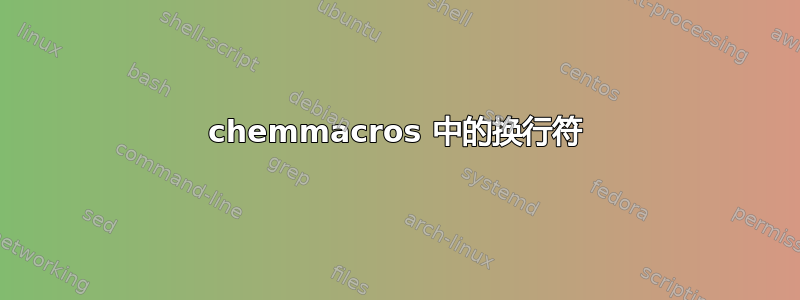
我对 LaTeX 还很陌生,我还没有在这个网站或手册中找到解决我当前问题的方法chemmacros。在这个例子中我有两个问题:
\documentclass{article}
\usepackage{chemmacros}
\chemsetup{modules={all}}
\begin{document}
In the presence of \ch{H2O2}, the chemical reaction of the formation of \ch{K2SiF6:Mn\pch[4]} can be represented by \begin{reaction}
(2 - 2 x) SiO2 + 4 KMnO4 + (20 - 4 x) HF + (4 - 2 x) H2O2 -> 2 K2Si$_{1-x}$Mn$_{x}$F6 + (4 - 2 x) MnO2 + (14 - 4 x) H2O + (7 - 2 x) O2.
\end{reaction}
\end{document}
首先,我想引入换行符(可能在箭头之后),因为反应太长,一行放不下。我尝试了一些常规换行符选项,但似乎都不起作用。
另一方面,我必须在系数中引入空格,使用(2 - 2 x)而不是(2-2x),以防止数字系数成为下标。也许如果可以解决这个问题而不使用额外的空格,我的反应就可以放在一行中。
答案1
使用reactions环境、\\和\notag。或者只使用数学环境amsmath和添加\ch{}化学。或者最好:使用 ,将amsmath其multline调整为反应环境。下面我还将您的输入更改为推荐的方式:
\documentclass{article}
\usepackage{chemmacros}
\NewChemReaction{multreaction}{multline}
\begin{document}
% using amsmath's `multline':
In the presence of \ch{H2O2}, the chemical reaction of the formation of
\ch{K2SiF6:Mn^4+} can be represented by
\begin{multreaction}
$(2-2x)$ SiO2 + 4 KMnO4 + $(20-4x)$ HF + $(4-2x)$ H2O2 -> \\
2 K2Si_{$1-x$}Mn_{$x$}F6 + $(4-2x)$ MnO2 + $(14-4x)$ H2O + $(7-2x)$ O2.
\end{multreaction}
% `reactions' with \notag:
\begin{reactions}
$(2-2x)$ SiO2 + 4 KMnO4 + $(20-4x)$ HF + $(4-2x)$ H2O2 -> \\
2 K2Si_{$1-x$}Mn_{$x$}F6 + $(4-2x)$ MnO2 + $(14-4x)$ H2O + $(7-2x)$ O2. \notag
\end{reactions}
% `split' in a math equation:
\begin{equation*}
\refstepcounter{reaction}\usetagform{reaction}
\begin{split}
\ch{$(2-2x)$ SiO2 + 4 KMnO4 + $(20-4x)$ HF + $(4-2x)$ H2O2 ->} \\
\ch{2 K2Si_{$1-x$}Mn_{$x$}F6 + $(4-2x)$ MnO2 + $(14-4x)$ H2O + $(7-2x)$ O2.}
\end{split}
\tag{\thereaction}
\end{equation*}
\end{document}



